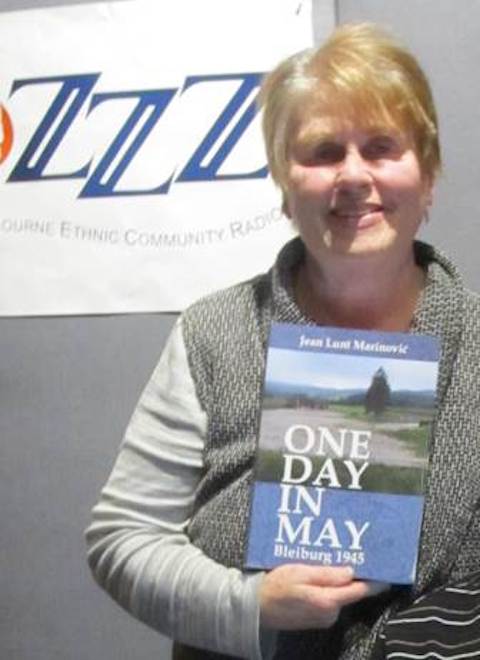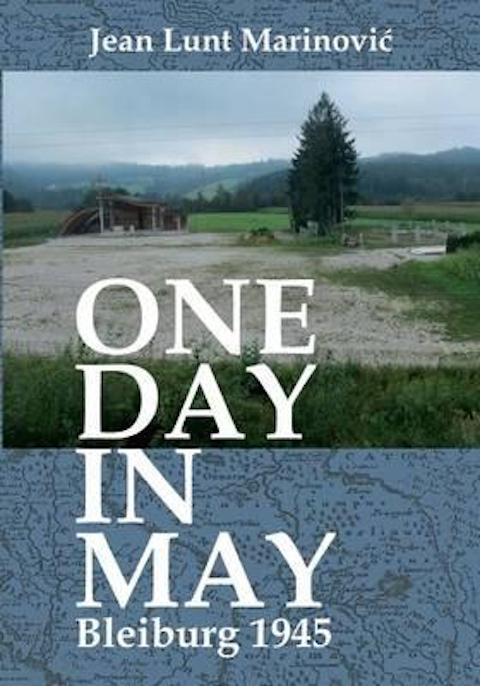Jean Lunt Marinovic has published One Day in May – Bleiburg 1945
http://www.croatia.org/crown/articles/10960/1/Jean-Lunt-Marinovic-has-published-One-Day-in-May-8211-Bleiburg-1945.html
By Violi Calvert
Published on 02/11/2017


 | The author's mission in 'One Day in May – Bleiburg 1945' is to provide an up-to-date narrative of events known as the 'Bleiburg Tragedy'. Written in the English language, this 314 page book focuses on the negotiations at the Bleiburg castle, includes maps and photographs, and provides answers to important questions using numerous sources, including British, American and Croatian. The author, Jean Lunt Marinovic, is of British background, has published over 100 articles in the Croatian-Australian media and has been active in the Croatian community since the 1980s. |
Why did Croats go to Bleiburg, Austria?

Jean Lunt Marinović at 3ZZZ studio
Melbourne Ethnic Community Radio, October 2016
Melbourne Ethnic Community Radio, October 2016
Author: Jean Lunt Marinović The author's mission in 'One Day in May – Bleiburg 1945' is to provide an up-to-date narrative of events known as the 'Bleiburg Tragedy'. Written in the English language, this 314 page book focuses on the negotiations at the Bleiburg castle, includes maps and photographs, and provides answers to important questions using British, American, Croatian and Yugoslav sources.
HOW TO BUY THIS BOOK: You can buy this book from any location in the world -- online from AMAZON books; or buy it in Australia from ebay, or Zagreb Croatian Bookshop in Melbourne. (The author, of British background, has published over 100 articles in the Croatian-Australian media and has been active in the Croatian community since the 1980s.) |

| One Day in May – Bleiburg 1945 by Jean Lunt Marinović Product details Paperback: 334 pages Publisher: Jean Lunt Marinovic ISBN: 9780646963747 Trim size: 254 x 176 mm Synopsis The Bleiburg Tragedy is named after the town of Bleiburg, Austria, the location of a post-World War Two surrender of Croatian refugees to the Communist Yugoslav Army. This exclusively Croatian surrender on 15 May 1945 was distinct from other surrenders in post-war Austria. The surrender negotiations are the main focus of this book. Although the Yugoslav officer guaranteed to treat the unarmed Croatian soldiers and civilians according to international law this promise was broken. Inside Yugoslavia over half a million unarmed Croats were sent on Death Marches and massacred. British, American, Croatian and Yugoslav sources are compared and contrasted to determine how and why this happened. For example, the Communist Bulgarian Army's refusal to allow the main columns of retreating Croats to cross the Drava River is exposed. The Bulgarians re-routed some of the columns towards Poljana, where they were attacked by Yugoslavs and eventually surrounded at Bleiburg. In addition, the Bulgarians also handed many of the other retreating Croatian columns to the Yugoslavs who sent them back towards Maribor on Death Marches. Tito's betrayal of his western Allies is revealed in the context of a bloody Bolshevik revolution – his consolidation of power included the strong Yugoslav occupation of southern Carinthia, Austria, and the liquidation of his Croatian opposition, and other smaller repatriated anti-Communist groups, inside Yugoslavia. Top ranking Serbian cadres in Communist Yugoslavia acknowledged the crimes against humanity. For example, Djilas remarked that Croats had to die so that Yugoslavia could live; and Rankovic admitted that 586,000 Enemies of the People were liquidated. This genocide did not escape the attention of world leaders at the time. Truman remarked that Tito killed more than 400,000 of his opponents to establish himself as dictator, and according to Churchill Tito's tactics marked the beginning of the Iron Curtain. Since the end of the Cold War and violent collapse of Yugoslavia, Tito's post-World War Two genocide is slowly being re-exposed due to the discovery of hundreds of post-World War Two mass graves. No one has been held accountable for these crimes against humanity. That is why the Srebrenica genocide happened, and why it was such a shock to the world. In 2014 in the Daily Mail Online's list of the world's most murderous regimes, Tito is listed to have slaughtered 570,000 of his political opponents. Once again the ethnic identity of his victims is not mentioned in the mainstream media. The legacy of the Bleiburg Tragedy for the small nation of Croatian people has been catastrophic. The memorial at Bleiburg, a place of an annual gathering, has become symbolic for the genocide against Croatian people. Although Croatia has been independent since 1992 false Yugoslav propaganda persists. History is not written by the victims. Grieving Croatian people are still being vilified. Justice and closure remain elusive. About the Author: Canadian born Jean Lunt Marinovic has published over 100 articles about the history and collapse of Yugoslavia in the Australian-Croatian media since the 1980s. The Croatian Viewpoint website features many of those past articles. For her Bachelor of Arts Jean studied Communist politics with a focus on the Yugoslav brand of socialism, and included a unit of Croatian language. Involvement in the Australian-Croatian community has included family and cultural activities. Jean also represented Croatian parents on the School Council of Saturday School of Modern Languages, and was co-founder and Coordinator of the Australian-Croatian World Congress's Croatian Exhibit at the Victorian Immigration Museum. Source www.bookstore.bookpod.com.au |
Formated for CROWN by Darko ®ubrinić
Distributed by www.Croatia.org . This message is intended for Croatian Associations/Institutions and their Friends in Croatia and in the World. The opinions/articles expressed on this list do not reflect personal opinions of the moderator. If the reader of this message is not the intended recipient, please delete or destroy all copies of this communication and please, let us know!